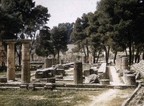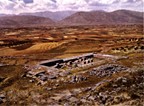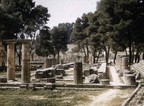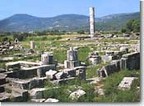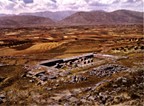Heraeum temple is an ancient temple also known as sanctuary which was dedicated to Hera queen of Olympian gods. There were many temples of this kind with the most important of them being the Argive Heraeum located about 5 miles northeast Argos in Greece. This is where Hera’s cult was actually established early in 750 BC. This is a location that was also home to a number of other temples of which the last known temple was Doric order which was designed by architect Eupolemos in 423 BC. The temple housed a very important gold as well as ivory statue of goddess Hera sculptured by Polyclitus.
There are many Heraeum temples in Greece. Most of these temples are located in Argos in Greece. Some of the temples are located in Olympia and others in Samos, all in Greece. There are other Heraeum temples in Lacinium close to Crotone located in southern Italy. Nowadays only the ruins of the Heraeum temple survives and still visible which is not an archeological site free for visiting by tourists and other holiday seekers and adventurers.
Heraeum temple was mainly destroyed by an earthquake in the early 4th century. However, it was never rebuilt. The Heraeum temple is a very significant location in the modern times. It is the place where Olympic torch is lit through focusing the rays of the sun.
This temple was a dedication to Hera wife of Zeus the king of gods. Hera was the queen of gods and the most important female deity. Hera was highly respected in Greek religion and many other temples were constructed and also dedicated to her. The temple basically depicted reverse of Greek 1000 banknote of between 1987 and 2001.
There are many other Heraeum temples that are also commemorated in archeological heritage of Greece. For instance, Heraion at Olympia which is located north of Altis and it is the oldest Peripteral temple in that site. It is also one of the earliest Doric temples in the country. It is also known that there might have been some other older cults in the location, this Heraeum temple was built in 590 BC as a dedication to Triphylian Polis. Originally it was meant to be dedicated to Zeus that will automatically be dedicated to Hera and later passed on it Tryphylia and then to Elis.
After the destruction of the Heraeum temple by earthquake it became difficult to rebuild as it was largely the times of archaic and roman and the carvings were done in contemporary times which differed in proportion and style significantly. In the late 2nd century Pausanias a travel writer saw a wooden column in Opisthodomos. The walls of the column had a bottom stone course with mud brick superstructure which is typical of Greek architecture.
Pausanias report indicated two cult statues which were all inside the naos and cella of this temple which were a seated Hera and standing Zeus. There is an archaic stone head that is on display which might belong to Heraeum statue. During the time of Pausanias this building stored many objects which include many statues of votive and deities offerings. Some of the many statues that survived include the statue of Hermes Praxiteles. This is one of the highly preserved examples of remaining Greek sculpture. The temple also holds a table upon which olive wreaths for victors are displayed in Olympic Games. However, nowadays, the Heraeum temple serves as a site for lighting Olympic fame.
From the Athens national museum you will find Argive Heraeum temple sculpture remains which is essentially Hera’s sculptured head. It was discovered in 1570 and dates back to 420 BC.
